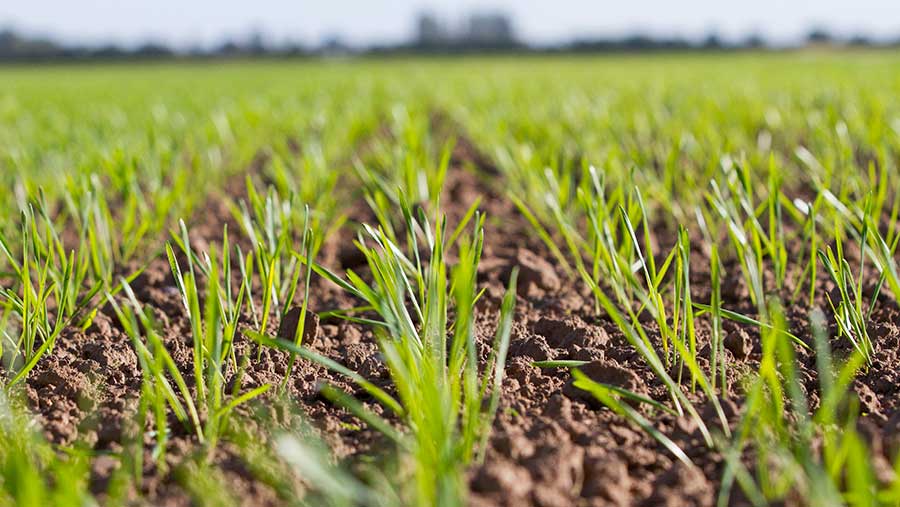Crop Watch: Warm spell raises BYDV threat in cereals
 © Gary Naylor
© Gary Naylor Aphids flying and soil being too warm for some residuals are the key topics this week.
The warm, dry spell in October may have improved wheat drilling conditions, but it has also brought the headache of oilseed rape propyzamide timings and virus risk.
Antony Wade says soil temperatures look like being too high for a while for the best propyzamide efficacy in OSR even though the bonfire night rule of thumb is almost upon us.
The warm conditions also mean some crops may need an insecticide with Marion Self highlighting reports that the number of barley yellow dwarf virus vectors (primarily the bird cherry oat aphid) are relatively high this season.
However, north of the border, Mary Munro believes slugs will be a greater concern than aphids.
Finally, Iain Richards reflects on the time taken for flushes of blackgrass to appear, despite being plenty of soil moisture.
See also: Potato blight strain causes resistance concern with agronomists
South: Iain Richards, Agrii (Oxfordshire)

Iain Richards
The driest spell since before harvest has really improved ground conditions. As a result, most of our later-drilled wheats have gone into better seed-beds than many end-of-September plantings on lower blackgrass risk ground.
Once again, our patience in holding-off on drilling has been rewarded. Most importantly, it has enabled us to spray-off two huge pre-planting flushes of blackgrass, much of which has taken a long time to come through despite more than enough moisture; a consequence of “high dormancy” perhaps?
Interestingly, we saw substantial early blackgrass germination too. Judging by the amount of growth already present when we desiccated our oilseed rape and beans, though, this came from high levels of early shedding. It’s sobering to see how much blackgrass can escape notice under tall crop canopies.
This season has really underlined that late drilling alone is not enough. For the most effective blackgrass management it has to be combined with the earliest post-harvest cultivation. Wherever this proved impossible we’ve only managed to eliminate a single weed flush ahead of wheat drilling, leaving plenty more seed down there.
Strong OSR growth
With our management attention so focused on wheat drilling, it’s good the winter rape is growing away so strongly. Until recently it was looking decidedly purple with very wet feet. But the dry weather has allowed it to pick-up impressively.
Only a handful of our crops had flea beetle problems and these have been far more to do with seed-bed condition than sowing date. Where we’ve had fine, firm seed-beds our insistence on vigorous varieties and seed-bed fertiliser has enabled the rape to grow away from attack. But where seed-beds have been cloddy it’s been a real struggle.
Solid phoma resistance has certainly come into its own this year. It’s a long time since we’ve seen so much early pressure from the disease.
While we’ve had to support some crops with an early curative spray, we haven’t seen a single lesion in varieties with the strongest resistance. So it looks like we’ll only need a single November spray with these again.
East: Marion Self, Prime Agriculture (Suffolk)

Marion Self
Good autumn weather has blessed us with some beautiful days and growers have been able to complete planned autumn drilling and spray applications.
Rainfall across the region has been variable; in most areas field conditions are dry. In drier areas seed-beds have been difficult to create, consequently, establishment has been patchy. However, most crops have now had a little rain and are becoming more even.
We are beginning to see how effective the pre-emergence herbicides and early sequences have been.
In some crops, blackgrass is emerging. Where sufficient populations are present at the one to two leaf stage we are applying residual top-ups or contact herbicides with a residual partner. Warm temperatures, dry days and moist soils provide ideal conditions for these applications.
Contact sprays such as Atlantis (iodosulfuron + mesosulfuron) have a drying time of about four hours which means heavy dews have the same effect on efficacy as rainfall, so daily workloads are limited. This window of opportunity is likely to be limited and such applications should be completed while grassweeds are still actively growing and before the cold.
Aphid threat
AHDB’s Aphid News reports that the number of barley yellow dwarf virus (BYDV) vectors (primarily the bird cherry oat aphid) are relatively high this season. Deter-treated (clothianidin) seed will protect crops from BYDV infection for about six to eight weeks post emergence.
Where Deter seed treatment has not been used (often second and later drilled wheats) these crops require protection at the two leaf stage.
Although conditions are mild and aphids continue to migrate, a follow-up foliar insecticide should be considered. The timing of this will depend on the time of emergence and the original treatment and temperatures.
Where seed is untreated, unevenness of establishment is making the timing of foliar BYDV control tricky. In these circumstances don’t leave the early emerged portion of crop exposed to infection while waiting for the dry areas to emerge, crops will need protection at the two leaf stage.
A swift follow-up treatment may be required to protect both ends of the emergence spectrum.
Many rapeseed crops have already received “additional” early grassweed control this season because blackgrass has flushed with vengeance in this early crop. In rapeseed, for optimum propyzamide activity wait until soils are cooling (10C or below at 30cm depth) and wetter.
Most crops have already received phoma treatment, as products give stronger protectant activity outstanding treatments should be applied soon. Some crops will receive a split autumn fungicide treatment with a follow up treatment tank mixed with the propyzamide.
West: Antony Wade, Hillhampton Technical Services (Herefordshire/Shropshire)

As All Hallows’ Eve is upon us and as we move into November with the ever-shortening days, the spectre of undrilled autumn fields are relatively few and far between in the West.
The dry first half of October allowed most drilling to be completed, there was even some dust flying. We seemed to miss the worst of the storms that hit further north, so in fact we needed some rain although the inch that arrived on the morning of the 20 October was a little heavier than we wanted.
The settled weather that I hoped for in my last blog did arrive; this allowed September-drilled cereals to be sprayed and early indications on weed control are promising.
October-drilled cereals have not all been sprayed as yet, so will be done early post-emergence, and those that do not have Deter (clothianidin) seed treatment are getting an insecticide as aphids are easy to find.
On the early-drilled wheat mildew pustules are starting to develop in the mild conditions, but this will not need treating unless it starts to affect tillering.
Although phoma came into oilseed rape crops earlier than it has for a few years, the dry first half of October has meant that it hasn’t developed to above threshold levels apart from the odd crop that was surrounded by previous OSR crops.
Monster OSR crops
The mild conditions have meant that most crops are pretty large with green area index’s greater than 1.5. Hence the risk of phoma causing stem cankers is reduced, therefore, a single autumn fungicide will be focused on light leaf spot and growth regulatory activity in the next couple of weeks.
Due to the size of some of the canopies, I will use tebuconazole or metconazole for growth regulation mixed with a modest dose of prothioconazole for light leaf spot.
Soil temperatures look like being too high for a while for the best efficacy for propyzamide even though the bonfire night rule of thumb is almost upon us so this will have to delayed until later in November or December.
Aphids can be easily found although larger plants are likely to reduce the impact of any turnip yellows virus, so only susceptible farms have been treated.
North: Mary Munro, AICC/Strutt and Parker (Perthshire)

Something different to write about – frost in October. While one overnight frost doesn’t make a winter, it signals a change from warm wet weather and perhaps a different pattern from the recent winters we have had in Scotland.
Aphids generally stop flying round about mid-October in the Lothians so the risk of barley yellow dwarf virus transmission drops off rapidly. There is still a fair bit of wheat to be drilled, if conditions allow, and while the insect activity declines, the slugs persist.
A tiny touch of frost might put them below the surface for a day or two, but they have extraordinary powers of survival. Wheat sown from now on will be slower to germinate and emerge, so is at risk from slug damage for longer than the crops sown into warm seed-beds.
Brome focus
The most forward wheat crops are tillering and have had their autumn herbicide. Our focus is very much on bromes, and to some extent annual meadow grass, rather than widespread blackgrass.
However, the number of known infestations increases each season, and we are now monitoring crops closely, and keeping up to speed on options for its control.
Winter barley and oilseed rape crops are looking well, and in most cases the herbicide is on. Propyzamide treatment of rape can be planned now the soil temperatures are dropping.
The lack of clarity regarding Brexit and potential trade deals is increasingly frustrating, and it is clear that some momentum is needed from within the industry. I am seeing some signs of this happening in the arable sector, through queries about varieties for specialist markets, alternative crops, and study groups such as the new Nuffield Export Group.
Farmers are independent-minded creatures and not always good collaborators, but this may be the time to look long and hard at co-operative ventures.

